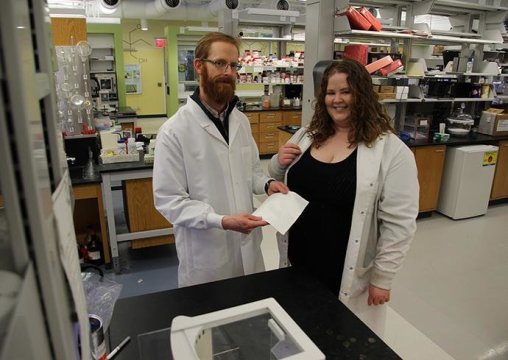[ad_1]
Researchers in the Syracuse University College of Engineering and Computer Science have developed a material — a new kind of shape memory polymer (SMP) — that could have major implications for health care.
SMPs are soft, rubbery, “smart” materials that can change shape in response to external stimuli like temperature changes or exposure to light. They can hold each shape indefinitely and turn back when triggered to do so.
SMPs have many potential biomedical applications. For example, they are ideal as cardiovascular stents because they can be one shape for surgical insertion and another once positioned in a blood vessel. The warmth of the patient’s body is all that is required to trigger the shape change.
Along with collaborators at Bucknell University, Syracuse University researchers have designed an SMP that can change its shape in response to exposure to enzymes and is compatible with living cells. It requires no additional trigger, such as a change in temperature. Given these properties, it can respond to cellular activity like healing.
“The enzymatic sensitivity of the material allows it to respond directly to cell behavior,” explains biomedical engineering Ph.D. candidate Shelby L. Buffington. “For instance, you could place it over a wound, and as the tissue remodeled and degraded it, the SMP would slowly pull the wound closed. It could be adapted to play a role in treating infections and cancer by adjusting the material’s chemistry.”
The research team includes Buffington, Justine E. Paul ’18, bioengineering junior Mark M. Macios, Professor James H. Henderson and Bucknell’s Patrick T. Mather and Matthew M. Ali Ph.D. ’18. Their research, “Enzymatically triggered shape memory polymers,” was published in Acta Biomaterialia this year.
The team created the material using a process called dual electrospinning, in which a high-voltage current is applied to two needle tips pumping two separate polymer solutions. The voltage draws out the polymer fibers, and they are blended into a fiber polymer mat. The proper combination of fibers gives the material its shape memory qualities.
Detailed in their paper, the teams analyzed the material’s properties, shape memory performance and cytocompatibility. Their experiments successfully demonstrated that the SMP’s original shape could be recovered through a degree of reversal, or degradation, of the shape-fixing phase.
Today, the research team is examining their SMP in cancer and macrophage cell cultures. They hope that with additional research, they will uncover practical uses for their material using lower concentrations of enzymes, produced by less extreme cellular activity.
“We anticipate that the materials we’re developing could have broad application in health care. For example, our SMPs could be used in drugs that only activate when the target cells or organ are in the desired physiological state, in scaffolds that guide tissue regeneration in response to the behavior of the regenerating tissue itself, and in decision-making biosensors that guide patient treatment more effectively,” Henderson says. “We’re very excited to have achieved these first enzymatically responsive SMPs.”
Story Source:
Materials provided by Syracuse University. Note: Content may be edited for style and length.
[ad_2]















